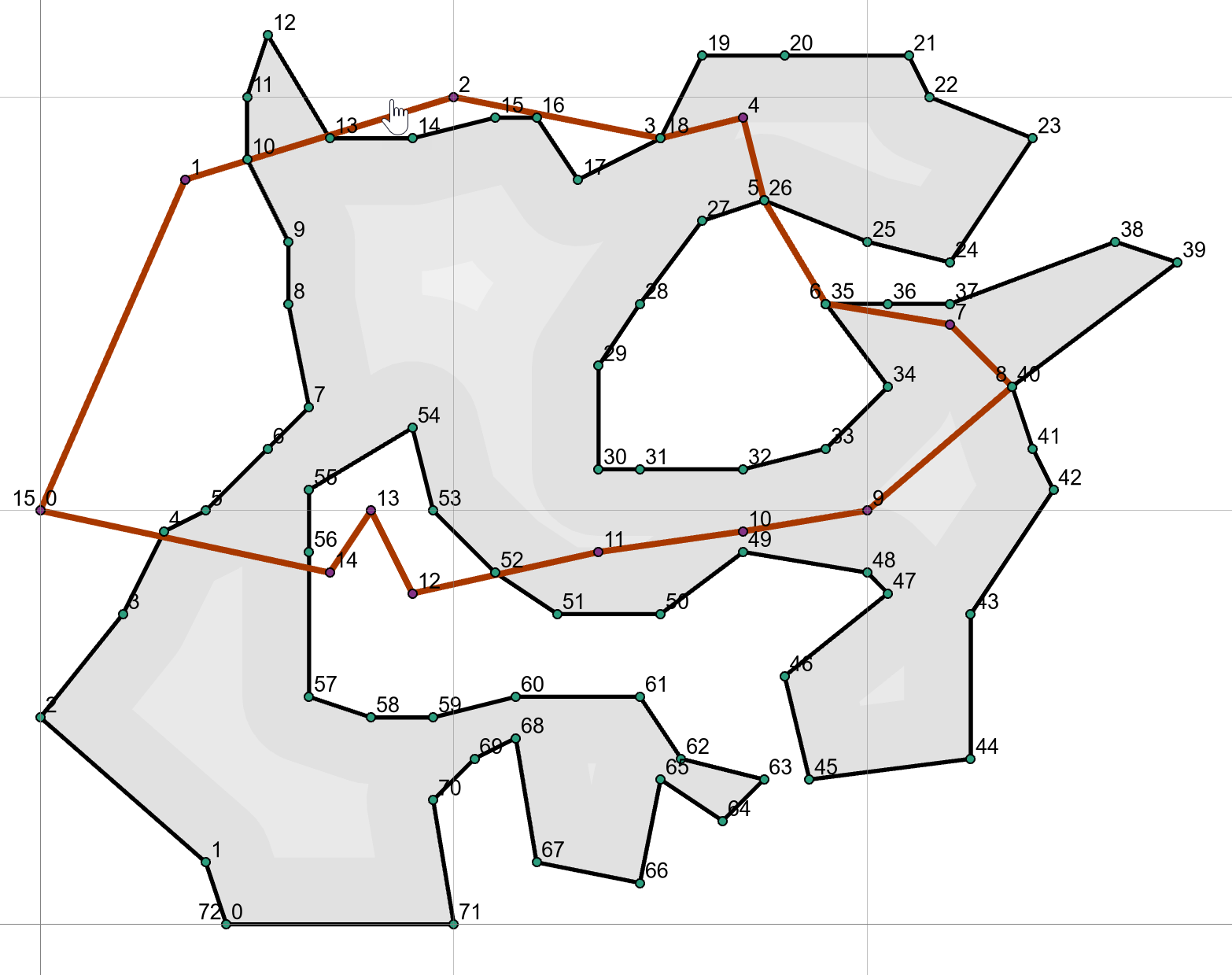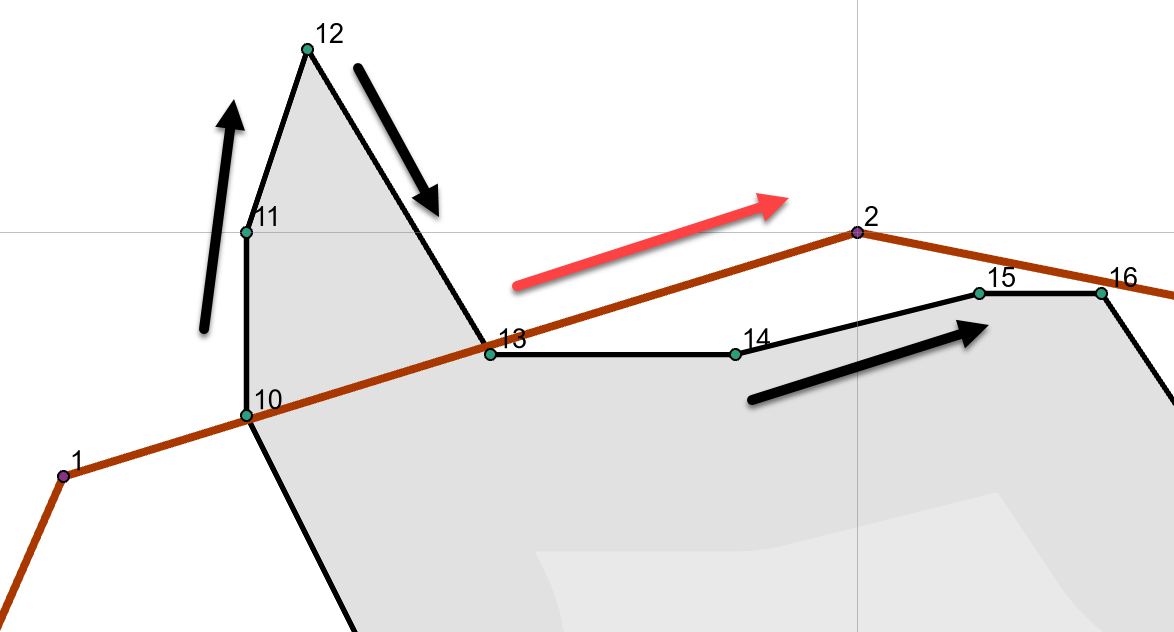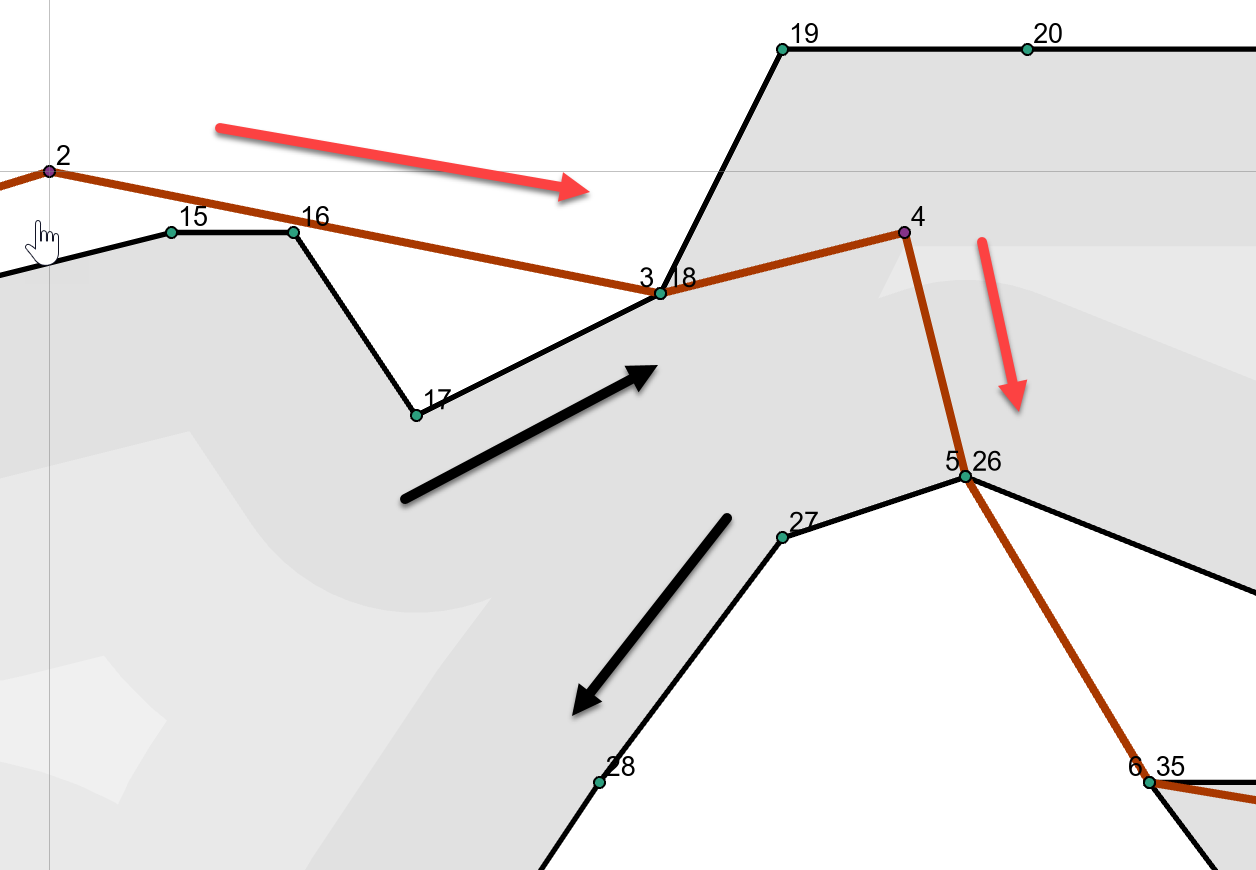Geo Numeracy
Working with geometry using numpy, and other musings.
Maintained by Dan-Patterson
Clipping ... beyond simple

Let us take a tour around the two polygon shapes to the right.
The top right hand corner of the image to the right is enlarged below. Clipping one shape with the other will obviously leave parts inside and outside the other.
The intersection points, for the most part, occur along the segments. Several intersections occur at the polygon nodes which creates special challenges during clipping.
Both polygons are clockwise oriented and their points are numbered.
If we assign the clipper polygon the variable name clp and the polygon being clipped poly, then the coincident points can be determined using numpy's nonzero and array broadcasting to do the comparison.
In this document, polygons segments are denoted using their start point.


The two polygons can be either the clipping polygon or the polygons being clipped.
Consider the red polygon as the clipping polygon and the black polygon as the one being clipped:
- segment 0 on the left side of the image, is formed by points 0-1. It has no intersections with the other polygon.
- segment 1 intersects segments 9 and 12, and the intersections are along the length of the segment
- segment 2 It looks like it doesn't intersect anything, but, its endpoint does. This type of intersection is the most problematic because it intersects the ...
- endpoint of segment 17
- start point of segment 18 and
- it also represents the startpoint of its own segment 3
- segment 3 its start point is the endpoint of segment 2, so it will share the same intersections as those found for segment 2
There are 4 intersections points that are similar to the one discussed above. I can identify those using a function to yield various point equality values. These are named in the code block below.
# -- clp and poly are Nx2 arrays of point coordinates with
# shapes of (16, 2) and (73, 2) respectively.
c_eq_p, p_eq_c = np.nonzero((clp == poly[:, None]).all(-1))
c_eq_p # -- clipper point equals polygon point
[3, 5, 6, 8]
c_eq_x # -- clipper point is an intersection
[3, 5, 6, 8]
p_eq_c # -- polygon point equals clipper point
[18, 26, 35, 40]
p_eq_x # -- polygon point is an intersection
[18, 26, 35, 40]
When paired, (3, 18), (5, 26), (6, 35) and (8, 40). If we look at the points generated by the intersection operation, you will notice that they are in pairs. The pairs can be extracted using the c_eq_x and p_eq_x values.
# -- intersection points are annotated
x_pnts # -- the intersection points for the segments
array([[ 5.02, 18.47], # -- clipper 1 intersections
[ 6.96, 19.06],
---
[ 15.00, 19.00], # -- c_eq_x and p_eq_x
[ 15.00, 19.00],
[ 15.00, 19.00],
[ 15.00, 19.00],
---
[ 17.50, 17.50], # -- c_eq_x and p_eq_x
[ 17.50, 17.50],
[ 17.50, 17.50],
[ 17.50, 17.50],
---
[ 19.00, 15.00], # -- c_eq_x and p_eq_x
[ 19.00, 15.00],
[ 19.00, 15.00],
[ 19.00, 15.00],
---
[ 23.50, 13.00], # -- c_eq_x and p_eq_x
[ 23.50, 13.00],
[ 23.50, 13.00],
[ 23.50, 13.00],
---
[ 11.06, 8.46], # -- clipper 11 intersection
[ 2.94, 9.37], # -- clipper 14 intersections
[ 6.50, 8.61]])
poly[p_eq_x]
array([[ 15.00, 19.00],
[ 17.50, 17.50],
[ 19.00, 15.00],
[ 23.50, 13.00]])
clp[c_eq_x]
array([[ 15.00, 19.00],
[ 17.50, 17.50],
[ 19.00, 15.00],
[ 23.50, 13.00]])
x0x1[c_eq_x]
array([[[ 17.50, 17.50],
[ 17.50, 17.50]],
[[ 19.00, 15.00],
[ 19.00, 15.00]],
[[ 19.00, 15.00],
[ 19.00, 15.00]],
[[ 23.50, 13.00],
[ 23.50, 13.00]]])
The intersecting segments point ids and whether they are inside each other are denoted in an array structure as follows:
# -- before processing
# -----------------
xCheck
# point ids | out/in => 0, 1
# c0 c1 p0 p1 c0 c1 p0 p1
array([[ 1, 1, 9, 12, 0, 0, 1, 0],
[ 2, 2, 17, 18, 0, 0, 1, 1],
[ 3, 3, 17, 18, 1, 1, 1, 1], # omitted
[ 4, 4, 25, 26, 1, 1, 0, 1],
[ 5, 5, 25, 26, 1, 1, 0, 1],
[ 5, 5, 34, 35, 1, 1, 1, 1], # omitted
[ 6, 6, 34, 35, 1, 1, 1, 1], # omitted
[ 7, 7, 39, 40, 1, 1, 0, 1],
[ 8, 8, 39, 40, 1, 1, 0, 1], # omitted
[11, 14, 51, 3, 1, 0, 0, 0],
[14, -1, 56, -1, 0, 0, 1, 0]], dtype=int64)
# -- after processing
# ----------------
np.asarray([i[0] for i in tot_])
array([[ 1, 1, 9, 12, 0, 0, 1, 0],
[ 2, 2, 17, 18, 0, 0, 1, 1],
[ 4, 4, 25, 26, 1, 1, 0, 1],
[ 5, 5, 34, 35, 1, 1, 1, 1],
[ 7, 7, 39, 40, 1, 1, 0, 1],
[11, 14, 51, 3, 1, 0, 0, 0],
[14, -1, 56, -1, 0, 0, 1, 0]], dtype=int64)
When processed, only certain intersections are considered to form the final clipped polygons. Consider the first intersection
point ids | out/in => 0, 1
c0 c1 p0 p1 c0 c1 p0 p1
1, 1, 9, 12, 0, 0, 1, 0
- Points c0, c1 belong to segment 1 and it intersects segments 9 and 12 (p0 and p1).
- c0 and c1 are outside the polygon being clipped.
- p0's start point is inside the clipping polygon while p1's start point is outside.
Each pattern is unique for the polygons being used. In general, the types of intersections and the point locations can be summarized by their combinations. One should note the polygons are considered in if they are on one of the other polygon's edges. This is an extension or interpretation of point in polygon to deal with boundary intersections. The combinations are as follows:
types of crossings
------------------
c0 c1 p0 p1
1, 1, 1, 1 all clipper and polygon points are coincident with the others segments
1, 1, 1, 0 both clipper segments are in/on
1, 1, 0, 1
1, 1, 0, 0
1, 0, 1, 1 - c0, c1 are not equal
1, 0, 1, 0
1, 0, 0, 1
1, 0, 0, 0
0, 1, 1, 1 only one clipper segment is in/on
0, 1, 1, 0
0, 1, 0, 1
0, 1, 0, 0 - end one clipper segment
0, 0, 1, 1 no clipper segment is in/on
0, 0, 1, 0
0, 0, 0, 1
0, 0, 0, 0 none of the segments are inside the others geometry, but they do intersect
You can do the same interpretation for the polygon as was done for the clipper. The first row and the last row in the table are special cases where geometries intersect at segment nodes.
When segment c0 and c1 are equal, this means a single segment intersects one or more of the other polygon's segments. Only the upper and lower block are possible, that is, c0, c1 must be 0 or 1 with no combinations.
When segment c0 and c1 are different, then you are dealing with 2 clipper segments and all combinations are possible.
Head spinning?
Good
We will get to the code in a bit. Enjoy following the rest of the polygon intersections in the images below, they will be referred to later.
The code has been placed in ...
https://github.com/Dan-Patterson/polygon_clipping

